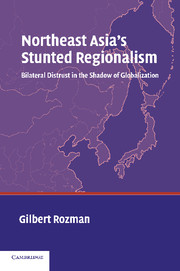Book contents
- Frontmatter
- Contents
- Acknowledgments
- Map
- Northeast Asia's Stunted Regionalism
- 1 Introduction: The Challenge of the Northeast Asia Region
- 2 Exiting the 1980s: Cold War Logic and National Aspirations
- 3 1991–1993: Border Fever and Cross-Border Duplicity
- 4 1994–1996: Civilizational Bridges and Historical Distrust
- 5 1997–1998: Strategic Partnerships and National Rivalries
- 6 1999–2000: Sunshine Policy and Security Dilemmas
- 7 2001–2003: Unilateralism and Irrepressible Regionalism
- 8 Conclusion: Lessons for Constructing Regionalism in Northeast Asia
- Index
1 - Introduction: The Challenge of the Northeast Asia Region
Published online by Cambridge University Press: 18 December 2009
- Frontmatter
- Contents
- Acknowledgments
- Map
- Northeast Asia's Stunted Regionalism
- 1 Introduction: The Challenge of the Northeast Asia Region
- 2 Exiting the 1980s: Cold War Logic and National Aspirations
- 3 1991–1993: Border Fever and Cross-Border Duplicity
- 4 1994–1996: Civilizational Bridges and Historical Distrust
- 5 1997–1998: Strategic Partnerships and National Rivalries
- 6 1999–2000: Sunshine Policy and Security Dilemmas
- 7 2001–2003: Unilateralism and Irrepressible Regionalism
- 8 Conclusion: Lessons for Constructing Regionalism in Northeast Asia
- Index
Summary
The 1990s were supposed to be the decade when the countries of Northeast Asia (NEA) coalesced into a region that is greater than the sum of its parts. Still a major center of development through the eighteenth century with the world's two largest cities (Tokyo and Beijing), it fell on hard times: first with an intensified inward-orientation in each country, then with the arrival of imperialism, and finally with impassable dividing lines lasting throughout the cold war. Suddenly, hope arose that a spirit of cooperation would turn NEA from the depths of division to the heights of integrated development. The result could be a rival for the European Union (EU) and North Atlantic Free Trade Agreement (NAFTA) and a framework for reconfiguring great power relations. Instead, the residue of the cold war suffocated the sprouts of regionalism. The potential remains; a breakthrough could be reached although further delay is likely due to reluctance to embrace regionalism by balancing globalization and nationalism.
At first glance, NEA would seem to have what it takes to establish a recognized community with its own formal organizations and regional consciousness. Parts of the area enjoy a high level of prosperity accompanied by determination to achieve economic integration with surrounding countries. The three core states of China, Japan, and South Korea have joined the World Trade Organization (WTO), committing to reduce barriers to economic ties.
- Type
- Chapter
- Information
- Northeast Asia's Stunted RegionalismBilateral Distrust in the Shadow of Globalization, pp. 1 - 20Publisher: Cambridge University PressPrint publication year: 2004



